Melbourne to Thailand
(by as much train as possible)
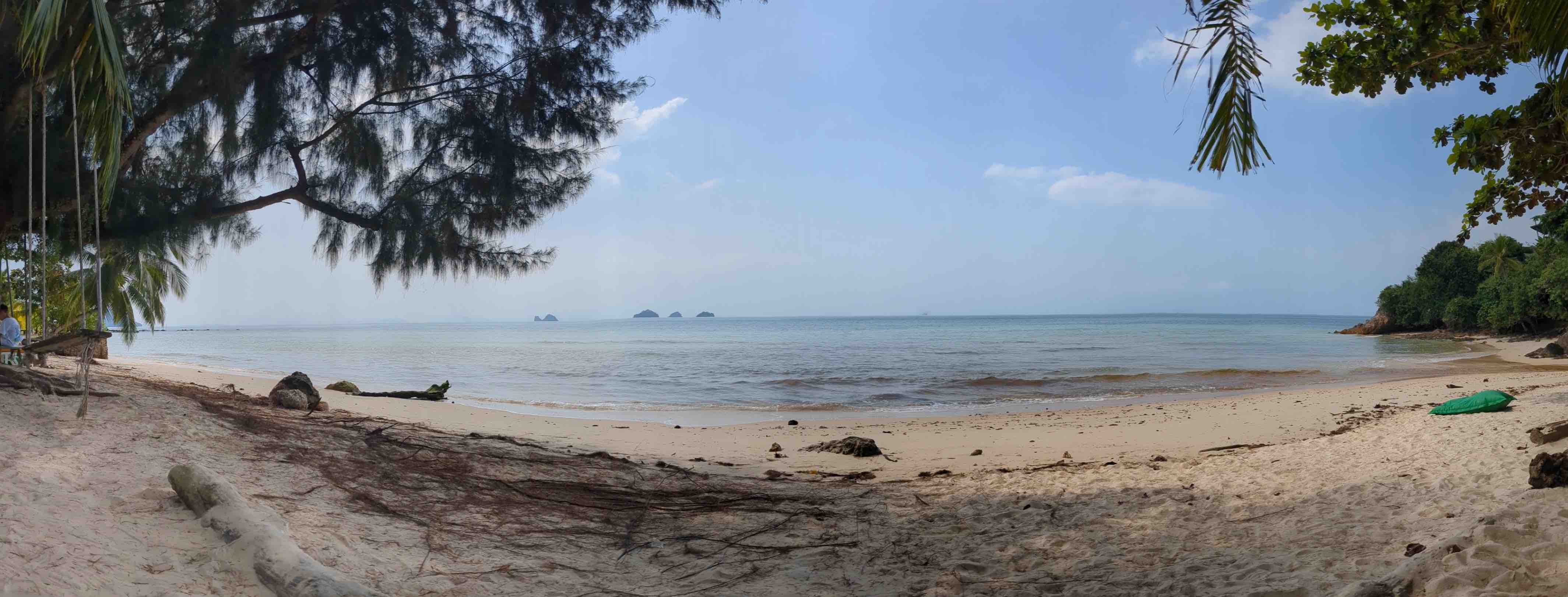
It was to be the first stage of getting to Europe with as little flying as possible. Trains from Melbourne to Perth; a flight to Singapore; trains from Singapore to Bangkok, with some island-hopping ferries. Here are some things we learnt1.
Heading West
11 December 2023. The 730-km train trip from Melbourne to Adelaide is aboard The Overland an old train that has been plying the route for many years. It has been spruced up by the ‘Journey Beyond Travel’ people, who now run it and other long routes across Australia. Unlike, say the Indian Pacific that we caught next, the Overland is still a service for people primarily interested in getting from point A to point B (rather than having ‘an experience’). It has economy and premium options. We went premium, which gives you more leg room and food service to your seat. It was comfortable and the service and food were good. Being an old train, there were no power points or USB connections in the seats, but there were charging points in the cafe. Pleasingly (for future trips), you can wheel your bike on to the goods carriage, although, on this grand adventure, we were travelling without bikes.
It is only a daytime service (so no sleeper option), and only operates twice a week usually. We left Melbourne’s Southern Cross Station at 8 am, and arrived in Adelaide around 7:30, two hours late because storms had taken out some rail signals. No matter! It helped us ease into the pace of slow travel. While the ride through the Wimmera and the Limestone Coast was not particularly picturesque, the Adelaide Hills in the late afternoon were pretty: green, wet and cloud-shrouded after the day’s storms.
As we arrived into Adelaide’s Parklands Station, they announced without a hint of irony, that the station is not serviced by public transport, and you’d need a taxi to get anywhere from there. Fortunately, we discovered during our three day stay in Adelaide that except for this major train terminal, much of the rest of the city is well serviced by public transport. It is an almighty shame that neither of the big inter-city trains that service Adelaide arrive at its Central Station, a grand building modelled after New York’s version.
The Overland’s timetable doesn’t coordinate well with the Indian Pacific’s, so we had three days in Adelaide between our Monday night arrival and Thursday night departure on the Indian Pacific (which were fun). railmaps.com provide lots more information on taking the Overland.
14-16 December 2023. The Indian Pacific is an expensive proposition: a minimum 2-3 times the cost per km of east coast train journeys, which includes a sleeper cabin, and all food and drink for the 2-day, 2,100 km (3 day, 4,350 km from Sydney) journey. It’s not a service that a traveller primarily interested in getting from one side of the country to the other would typically choose. Billed as an ‘experience’ or a ‘journey’, it is more akin to a cruise, and that was reflected in the types of people we met on the trip (many of whom were joining a cruise at Perth).

The train itself is about a kilometre long, but one’s experience is largely restricted to 3 carriages (your sleeper carriage and your allocated bar and restaurant carriages). It is certainly an experience that helps you appreciate the vastness of Australia, especially the two stops on the Nullarbour Plain that allowed us to get out and experience the hot, flat, treeless expanse.
But our main interest in catching the train was to cover some significant distance toward Europe without flying. And frankly, a simpler, cheaper service like the Spirit of Queensland offers would be a much better proposition for us.
Unlike our experience on The Overland, we didn’t witness anyone transporting their bike on the Indian Pacific. When we asked if it was possible to take ones bike on the trip, it wasn’t a straight yes, as it is not a common request, but they did suggest that their operations team would do everything they could to accommodate such a request.
Despite some significant time lost between Sydney and Adelaide (an apparently rare occurrence, in this instance because of industrial action), they managed to make up the time and we rolled slowly into the incredibly long platform at East Perth station on time on a hot summer’s afternoon.
Around Perth
16-26 December 2023. Perth’s heat when we arrived was a shock, but we learnt to love its perfectly cool evenings and early mornings. We began by staying in the CBD and made good use of their frequent free CAT buses that cover much of the city and its surrounds. We hired a flexicar (one of Perth’s few) for our few days down to the Margaret River region. And we used the very good train service to and from Fremantle a few times. A shining highlight of Perth’s train network is the line to the airport, which gets you there for the cost of a Zone 2 ticket. (How hard can it be, Melbourne?)
We had to take the train to the airport to get our difficult-to-avoid flight to Singapore. We had made several enquiries to see if we could get a berth on a freight ship to Singapore, but received no replies. I have read that, since the pandemic, passenger berths on Freight ships have become almost impossible to find.
Around Singapore
26 December 2023 - 1 January 2024. Our five-hour Boxing-Day flight to Singapore (Singapore Airlines: pretty good) arrived at 10:30 pm. I was quite keen on the prospect of catching the train from the airport into Bugis (central Singapore where we were staying). By the time we cleared customs and found our way to the station it was about 11. As we descended the elevator to the platform, we heard the announcement that the awaiting train was the last service to the city. We had a micro-panic and rushed on (greatly relieved that our debit cards worked a charm to get us through the barriers), but then sat on the train listening to the same announcement being repeated for the next 20 minutes before the train finally left.
Singapore’s train network (the Mass Rapid Transit System, MRT) is amazing. They have managed to build a system rivalling London’s underground in just 30 years. After a little nervousness about changing lines at interchange stations, we quickly found ourselves using the system like locals to explore much of the island. Being able to use our debit cards to tap on and off was easy and cheap.
Much like the London tube, we did find that the underground rail system can hinder getting to know a city’s geography. (I really wish I had found the above map while we were there: much better than the stylised map on the trains). We took a few trips on buses to help get our bearings a bit better (also tapping on and off with our debit cards), but navigating the bus system is not as easy as the trains. We found this website the most useful for working out which buses to catch.
Walking far during the heat of the day was not very appealing (although we did do some substantial walks to the Botanical Gardens [great] and the tree-top walk in the water supply catchment [not as great as we’d hoped]). We left it until our final night to finally get our heads around the inner city geography by walking from our hotel in Bugis across and along the river front to downtown (for a night out in the Lau Pa Sat night market and its neighbourhood). It made us wish we had done a bit more (night-time) walking during our week in Singapore.
North to Surat Thani ,Thailand
2 January 2024.
Singapore to Johor Bahru (JB), Malaysia. We found planning to get from Singapore to Malaysia by public transport tricky. It seems that by 2026 it wil be as simple as catching a train to Woodlands North and changing to the planned link to Johor Bahru (as shown in the map above).
We had booked a couple of seats on the existing Malaysian Shuttle train to JB Sentral station2, and catching that requires getting to the Woodlands Train Checkpoint. We probably should have followed these instructions to get there via the 856 bus. But we didn’t! We caught a couple of buses to get there that took a long time, bypassing the Woodlands Train Checkpoint, but managed to find ourselves in JB Sentral all the same (after 3 hours of travel and border crossings).
So, while acknowledging there may be better ways to cross the border, here’s how we managed it. From Bugis, we caught the 197 bus along Northbridge Road to the Jurong East Bus Interchange. The interchange was being refurbished, and we had to walk (a few hundred metres) to the Jurong Town Hall Bus Interchange to catch the 160 bus to Woodlands Bus Checkpoint. Presumably, that change will be easier in the future.
On the way to the bus checkpoint it became apparent that walking from there to the train checkpoint was not going to be possible, so we just followed the crowd to enter the checkpoint at the bus stop, and, having cleared the Singapore checkpoint, jumped on a second Singapore bus to the Malaysian JB Sentral checkpoint. Entry into Malaysia was less automated and friendly than into Singapore, and we had to spend some time filling in the entry forms (that we really should have done earlier). By good fortune rather than good planning, passing through the JB Sentral bus checkpoint took us to the right place. It was a longish, but indoor, walk to the JB Sentral train station, where we arrived with only half an hour to spare before the train north to Gemas (which we had booked) departed. The signage at JB Sentral left a bit to be desired, and we needed to ask for advice on when and where our train was departing from.
There was only one ATM at JB Sentral station, which wasn’t working. There are a few money changers there, so it was lucky we had some cash to change into Malaysian Ringgit.
JB to the Thai Border. In the week we were in Singapore, after a cursory read of the man in seat 61’s advice, we booked a train from JB Sentral to Gemas (arriving around 6:30 pm), and booked a hotel for a night there, to catch the 8 AM train from Gemas to the Thai Border at Padang Besar (arriving at 4:40 pm). The Thai train to Surat Thani leaves Padang Basar at 4:30 pm, and it took a bit of brain strain to work out that this left 50 minutes to cross the border to catch the Thai train (there’s a one-hour time difference). It was going to be tight, but we thought we’d give it a crack3 and try not to stress too much about the possibility of not making the connection.
It all worked out fine, but in retrospect we probably would have done a couple of things differently. The train from JB Sentral goes to Gemas because that’s how far south the railway electrification project had got. In a couple of years, it will be electric trains all the way from Johor Bahru to the Thai border, but for now, you need to change to an electric train at Gemas. In retrospect, we probably would have caught a train for a late night arrival in Kuala Lumpur that evening from Gemas, and had a rest day in KL. And we probably would have caught an earlier train out of KL to Padang Besar to ensure that connection at the border. But what we did was fine, and it gave us a chance to experience rural Malaysia off the beaten tourist trail that beckoned over the Thai border.
Truth be told, because I stuffed up the bookings, we had two nights in off-the-beaten-track Malaysia: one night in Segamat, a larger town just up the road from Gemas, and a second night in Gemas. Neither were places that are likely to become tourist destinations any time soon, and we were asked several times, how on earth did we end up there?
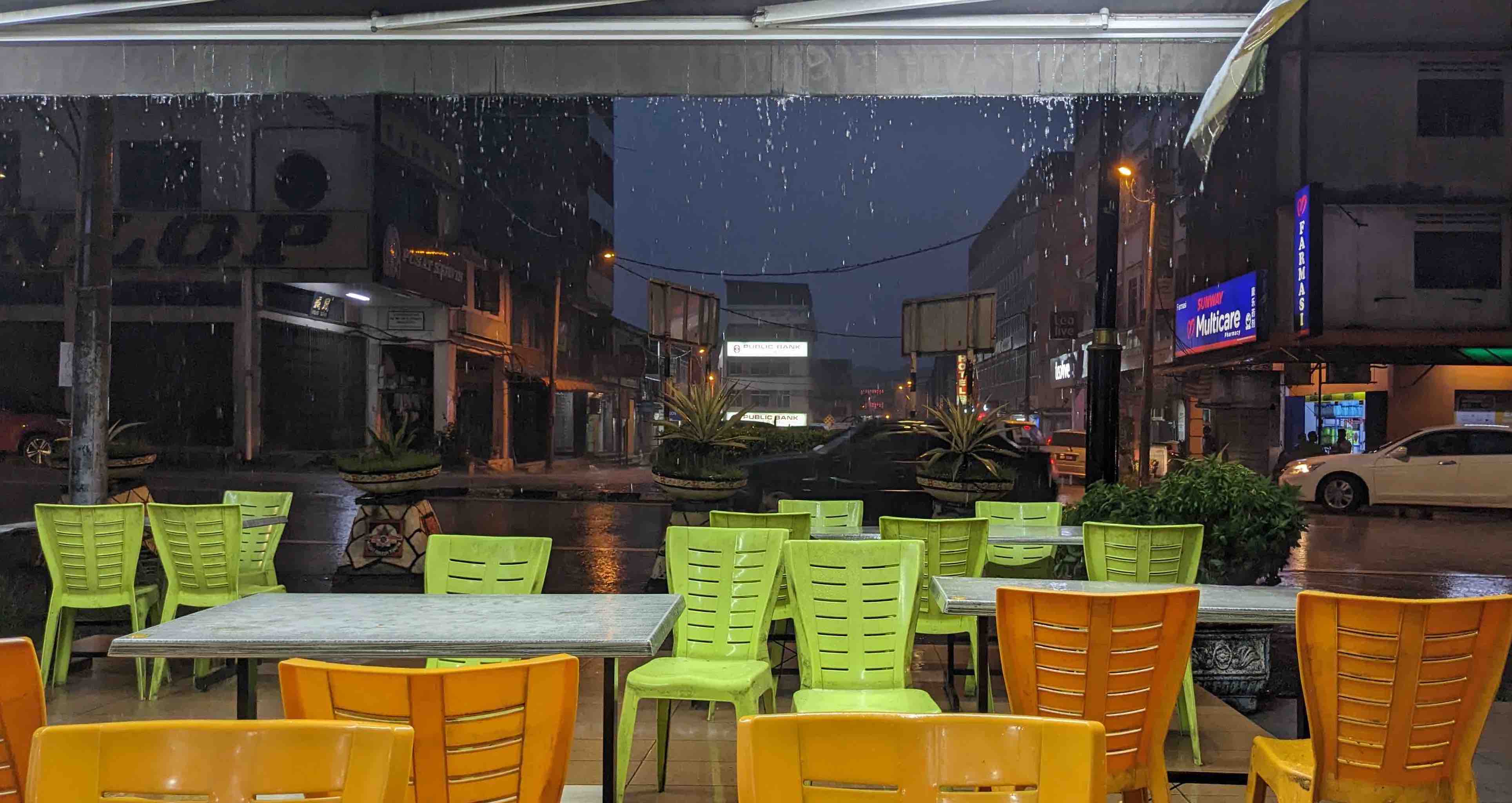
4 January 2024. Bright and early, we wandered down from our hotel (The Tropicana!) to Gemas Station where we were well looked after by station staff and directed to the train that was waiting at the station 30 minutes before departure time. Despite our best efforts to not stress about making that connection at the border, we were worried enough to visit an ATM the night before to ensure we had enough cash for anything unforeseen.
But it turned out to be a great day: a classic experience of edge-of-your-seat train tourism. The train took us through much more interesting and varied country than the trip to Gemas - bigger cities, more varied agriculture in between, and more mountains and caves and rivers. It was a long but bearable trip (8:05 to 16:50). The food on offer in the ‘bistro’ was not at all enticing (pre-cooked microwave monstrosities), so we survived on our pre-bought stash of peanuts and wafer biscuits.
We had prepared ourselves so that we wouldn’t get too stressed if the tight connection between the Malaysian and Thai trains didn’t work as planned, so we were in a good frame of mind to move smartly but calmly when the train finally pulled slowly into Padang Basar station (having averaged top speeds of 140 km/h most of the way from KL, it stopped for a nail-biting 5 minutes waiting for a signal change as it pulled into the station). Out we strode, somewhat confused by the line of people waiting in a direction labelled “Platform” - that looked hot and slow, so we kept going to the exit to the left of the station (it turns out that direction could have worked, but we made the right decision…see below).
At the exit we were met by a gaggle of drivers who wanted RM30 to take us to the Thai border. This may have been a bit of tourist fleecing: they told us the exit to the right of the station, close to immigration was closed for renovations and it was a 5 km trip around from this exit to the checkpoint. But being aware of the clock ticking we decided to accept, and off we went. What a good decision! Our chosen driver drove us around, right up to the Malaysian check point, and we were able to do passport control from his car, and then he drove us straight to the Thai checkpoint, where we were the only people waiting to be seen. Despite being prepared for tricky questions about flights out of the country (as we were asked on entering Malaysia), we were asked no questions at all - just filled in the forms, had our fingerprints recorded and our passports stamped.
We were out in Thailand 15 minutes after getting off the train! At this stage we still had 25 minutes until the train was due, so we asked a waiting taxi driver to take us to a bank, and we ended up not bothering with an ATM, and just exchanging all our left-over ringgit for baht (we gave the driver 120 baht for getting us to the train, which he was very happy with). We had a euphoric 20 or so minutes waiting for the train to arrive in the cool of the Thai Padang Besar station.
The train arrived from the direction of Malaysia, and a young American traveller on it told us that there was another way to do what we just did. He had arrived from KL several hours earlier and had booked the Thai Train from Padang Besar (Malaysia), rather than Padang Besar (Thailand) where we got on. At the Malaysian station he had taken the hot hallway in the direction labelled “Platform” doing the two checkpoints in the station. It meant he had 4 uncomfortable hours in the hot, un-airconditioned Malaysian station. On paper, what he did is the more sensible way to do it, but our unconventional approach unexpectedly worked like a charm and we managed to cross the border and change trains without breaking a sweat: that was well worth the few dollars extra we paid.
Padang Besar to Surat Thani. And when we finally joined the Thai train, it was an utter delight. Sleeper cabins like in ‘Some Like it Hot’, and it was just us and our American friend with the carriage to ourselves. He allayed our concerns about not having eaten anything, telling us that the dining car should join the train at Hat Lai (which it did). In fact at Hat Lai, some nice ladies came around with chicken and rice A bit later when the conductor was making our beds (for a 10:45 wake-up at Surat Thani).
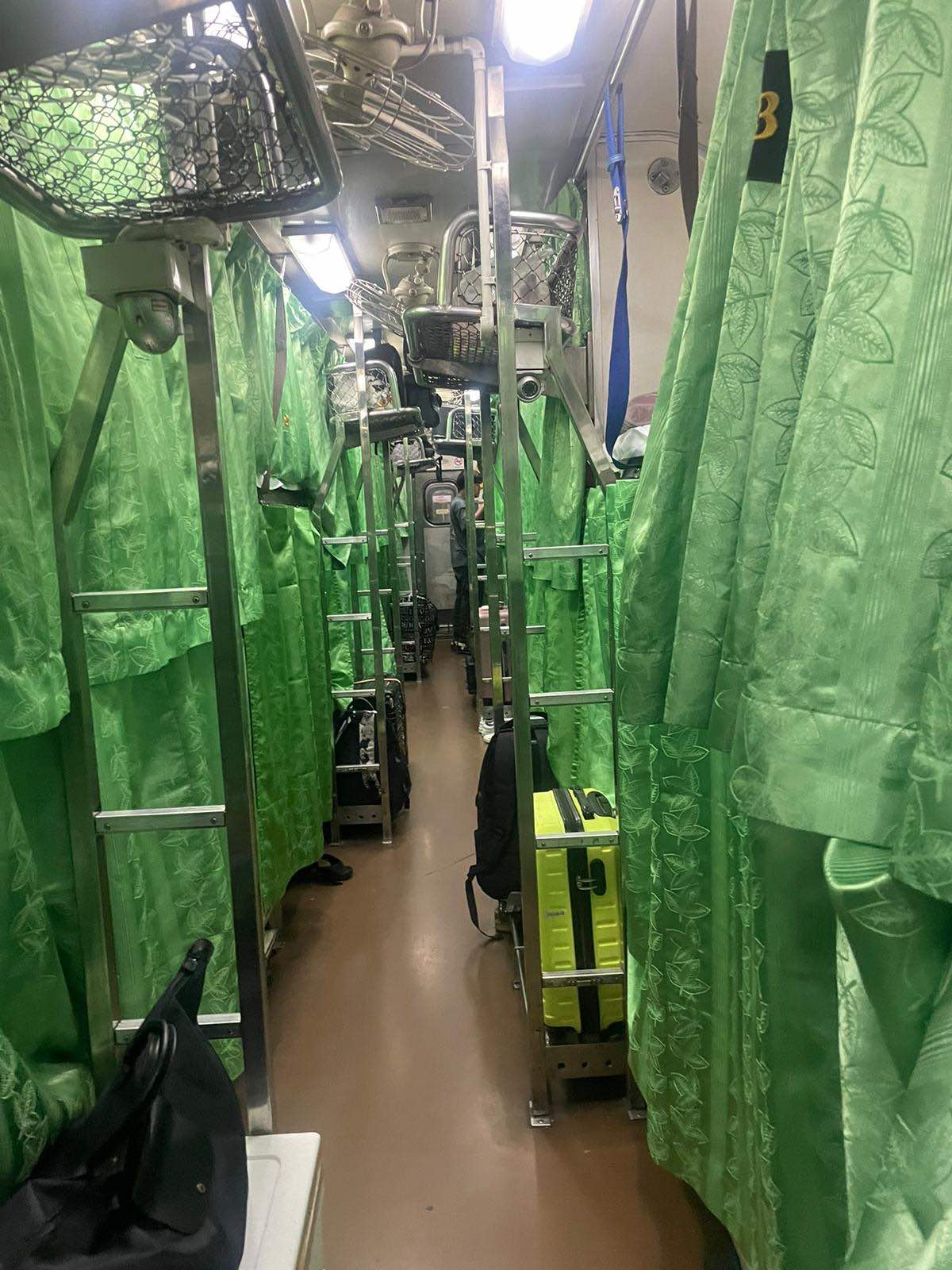
Having declined the chicken and rice, I decided to check out the dining car was 6 carriages down through another two sleeper carriages, and three lower-class, sit-up cabins, with open windows. It felt very adventurous jumping from carriage to carriage with the doors of most carriages wide open as the train sped through the countryside. The food carriage was fantastic. Open windows and fans; 8 tables with bench seats, and just me and two other fellows. I ordered a set meal (a tasty prawn and rice soup, an orange juice, a tea and a plate of pineapples slices for 150 Baht), and sat next to the window and stuck my head out to feel the breeze and look into the gorgeous sunset. The food was great: prepared fresh in the kitchen (compared to the plastic monstrosities on the Malaysian train), and when I decided to take half my pineapple back to sleeper, the kind lady took my plate, added more pineapple to make it a full serve and wrapped it in glad-wrap.
And at the end of it all, we managed to cover over 1000 km today to get to Surat Thani by 11 pm. The conductor came around to wake us up as we approached and proceeded to change our little-used beds for the next passengers. At the station, there were none of the expected taxi drivers touting for business, so we had our first go at Grab, which worked well: a car arrived within 5 minutes and took us the 6 km to our hotel for 180 Baht (a somewhat terrifyingly fast caper through the late-night streets of Surat Thani with seatbelts only for the second half of the journey, as it took us that long to work out how they worked).
Island hopping north.
5-15 January 2024. We had decided to break the train trip to Bangkok island hopping to Koh Samui, Koh Pha Ngan and Koh Tao before rejoining the train further up the coast at Chumphon. This detour certainly took us onto the well-worn tourist trail, so we won’t labour the details too much.
Sufficed to say that it was with mixed emotions that we returned to these islands after 38 years. The island beaches remain beautiful (where they haven’t been washed away), but with a lot more plastic pollution than I remember, and the inland urban roads of Koh Samui are crazy busy. Nevertheless we did manage to find a couple of beautiful, clean, quiet beaches, even on Koh Samui. We hadn’t been to Koh Tao, the smallest of the three, before and were surprised how busy a tourist destination it has become.
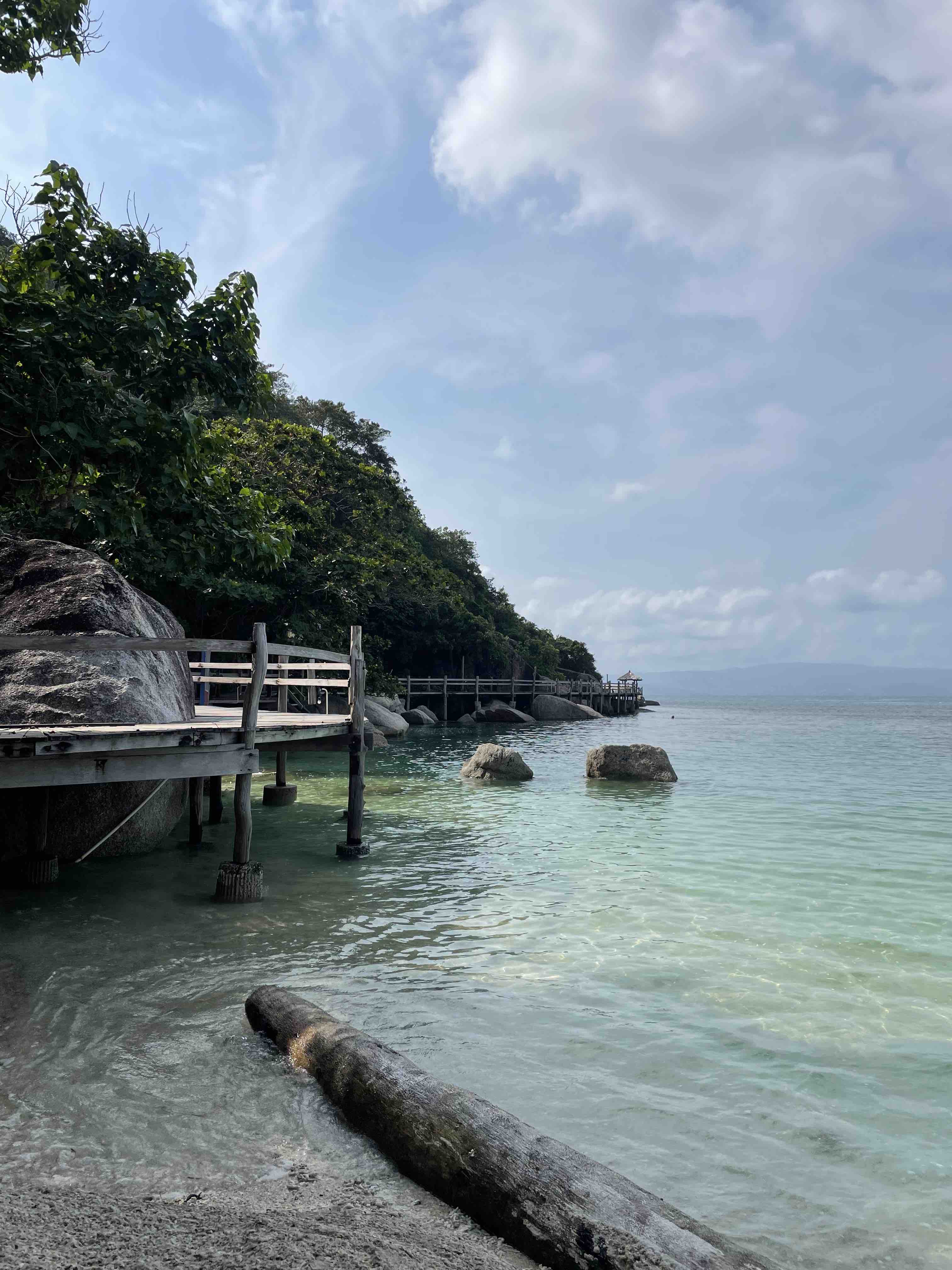
We used Lomprayah Ferries on all three legs and they were generally good (the stress level of the check-in process varied with port). You can’t book ferries on the web on the same day, but if you just rocked up on the day, you’d get on, at least when we were there. We left Surat Thani from Tapee pier, which is only 6 or so km out of town, which made (we think) for a more interesting ferry ride than leaving from the more distant pier. Lomprayah’s 150 baht shuttle buses were good value, particularly the very long drive from Chumphon pier to the train station. Grab worked well on Koh Samui but not the other two islands. Hailing tuk-tuks is easy and cheaper (and more fun).
Our island hopping time was constrained by plans we had made on our rest day in Surat Thani. We had decided that we needed to return home rather than continuing Europe-ward. So we booked a sleeper train from Chumphon to Bangkok on the 15th and another sleeper train on the night of the 16th to Chiang Mai for four days before a flight home on the 24th.
Alas, on the morning of the 15th on our walk back from a final swim at beautiful Freedom Beach, we received a call that meant we needed to be home as soon as we could. At this point, we were very grateful for our decision not to book a cheap budget-airline for the trip home. After a couple of emails from Koh Tao and a phone call once we were on the bus to Chumphon, Thai Airways had managed to move our flight forward to the 17th, making the changes for a princely charge of 80 baht4. Suddenly the train to Bangkok was to be our second last night in Thailand.
Chumphon to Bangkok, and home
The Lomprayah bus dropped us at Chumphon station, leaving 6 hours to kill before our 10:40 pm sleeper train departed. The restaurant over the road from the station runs an informal luggage storage business (for contributions to the their tip bucket). So, we left our bags there and had a walk around the markets and shops before settling on one of the other restaurants opposite the station for a long dinner and beers and games of pool until we had only a couple of hours to kill. After another walk along the road to find the ‘live music’ district of Chumphon and a long sit in the station waiting room, our train was at last due.
We wandered down the path to the platforms, asking one of the railway officers which platform our train left from: Platform 3 we were told. And as we approached platform 3 just before 10:40, we realized there was a long train sitting at the platform which we assumed was ours (the lack of signs was even worse than at Malaysian stations). By the time we had walked most of its length to reach our carriage, we found the door was locked and the train started slowly departing. We jumped and yelled, and amazingly the conductor called the train to a stop and ran down to ask (remarkably politely) to see our tickets. Of course this wasn’t our train: ours will arrive soon. Suitably embarrassed, we sat down and watched the not-our train head off towards Bangkok.
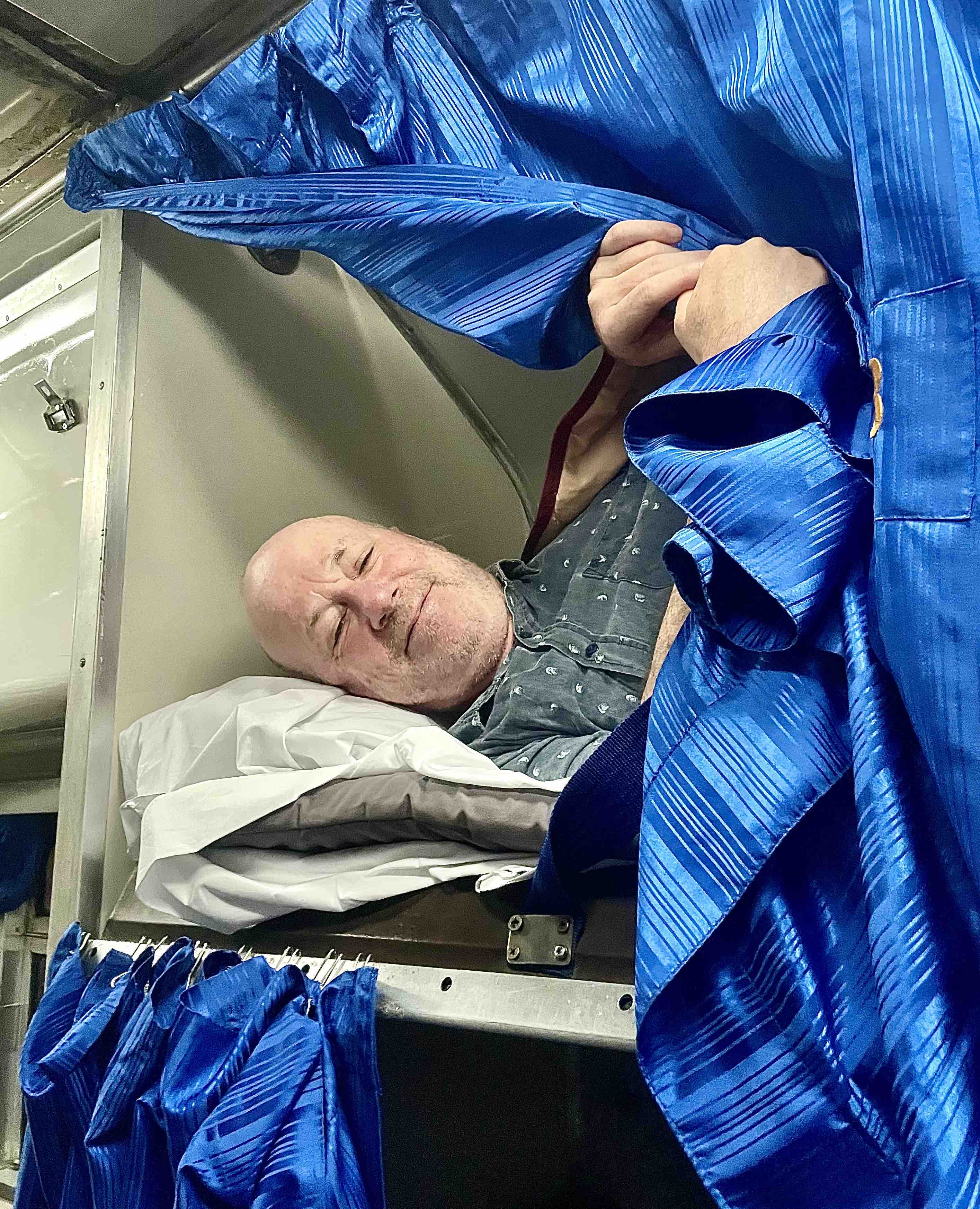
Our train ended up being half-an-hour late, and we climbed back into the carriage just like our last, and gratefully lowered ourselves onto our made beds. I slept better once I had taken a shower in the squatter toilet: the shower works well, with the main challenge being not to fall down the toilet. The romance of the Thai sleeper train was somewhat eroded by the noisiness of people coming through yelling from 5 am onwards, but it was comfortable enough. By 6 am, they had come through and converted all the beds back to seats and we watched the sun rise over Bangkok as we rolled through its suburbs into Apiwat Central Station.
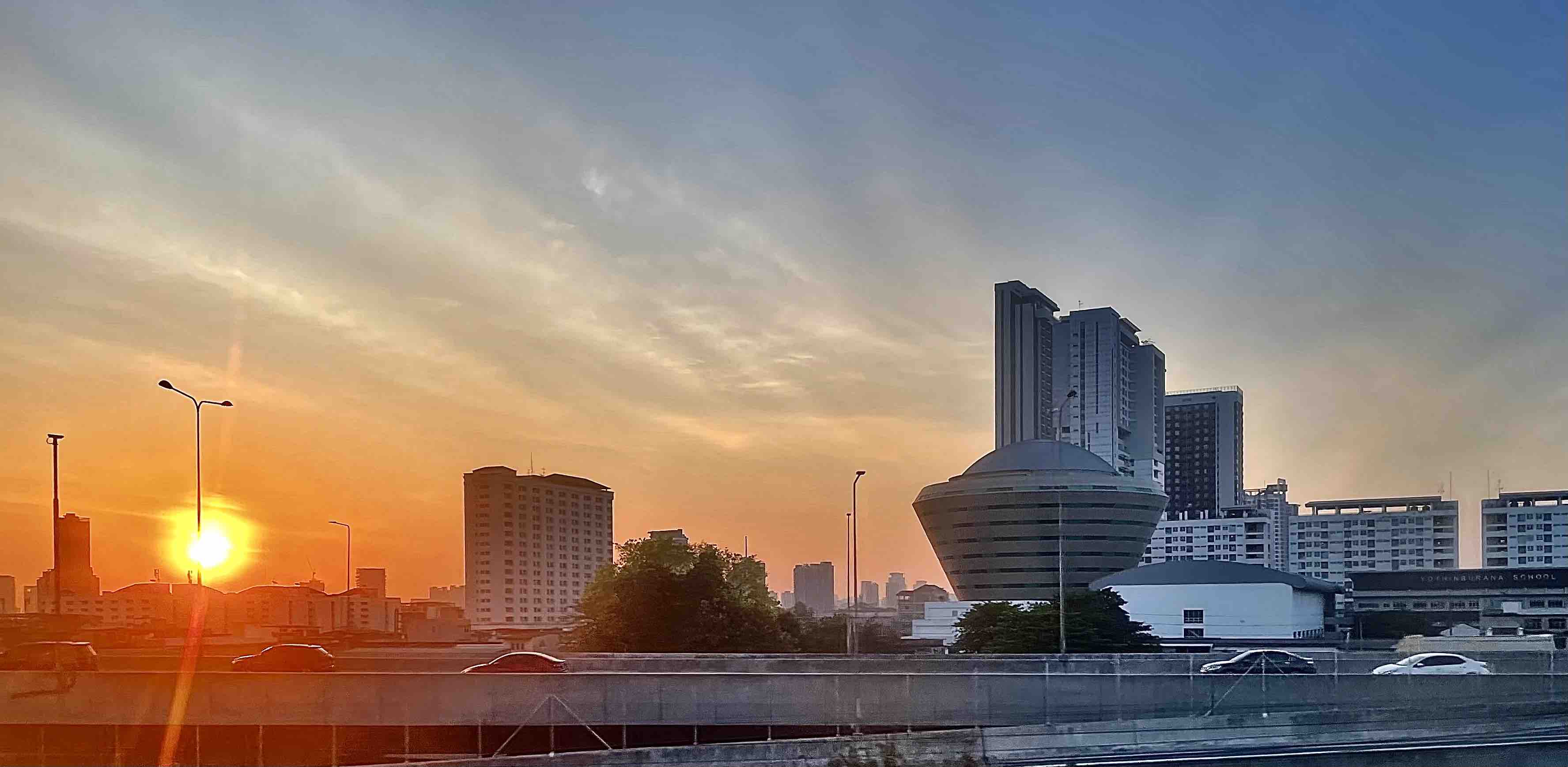
The station is new and huge. It took a long walk to find the left-luggage lockers (near Gate 4), and then across to Gate 3 to find a taxi to take us into Phaya Thai station, where we thought we might look for a place to stay. The Central station is not particularly central, and it was a 6-km drive in peak-hour traffic to get there. After some breakfast, we wandered the back streets to the first hotel that took our eye on the internet (N.A.P.), and asked if we could get a room for the night. It was a very pleasant surprise to find that they were happy for us to check in there and then at 9:30 am, giving us an opportunity to catch up on some lost sleep. (We later had a hair-raising tuk-tuk ride back to the station to pick up our bags).
It occurred to us that, even if we were going to go on to catch the night train to Chiang Mai as we had planned, it would have been a great idea to get a hotel room like this, with a 9:30 check-in, to rest between two consecutive restless nights on sleeper trains. But alas it was not to be: we had one last day wandering the busy streets of Bangkok. It was a 4:00 am rise to get the airport the next morning from where we saw our second Bangkok sunrise before the long trip home…
Footnotes
You can take your bike on the Overland between Melbourne and Adelaide, and you might be able to take it on the Indian Pacific as well, but their advice was to ring and discuss. (We didn’t investigate the possibility of bikes on trains in Malaysia or Thailand, because bike riding anywhere there is well beyond our take-it-easy limits.)
Buy paper tickets on Adelaide and Perth trains. In Adelaide, the ticket machines are on the trains; In Perth they are at the stations: City to Fremantle or to the Airport = a 2-Zone ticket.
Use your debit or credit card to tap on and off Singapore’s public transport system. If your card doesn’t charge you international transaction fees (some don’t), it’s cheaper than buying a ‘tourist’ pass.
busrouter.sg is a good site for navigating Singapore’s confusing bus network.
Before entering Malaysia, complete the Malaysian digital arrival card and install the KTMB mobile app (Android/iOS) for booking and presenting Malaysian train tickets.
Grab is an uber-like app that works well in Singapore, Malaysia and Thailand. Drivers and cars generally good, and prices are a good indication of what you should pay for taxis
Book Thai trains through the Thai Railways Booking page. If you don’t read Thai, get Chrome to translate it. Apply for membership (the field that doesn’t translate will probably be your passport no.). You’ll need to scroll through station names: the list can be shortened by selecting a line: the main Bangkok station is near the bottom, called “Bangkok Apiwat Central Station”. This site provides options for selecting your seats, and for applying for cancellation refunds that are not available on 12go.asia.↩︎
We made our bookings on the KTMB website, but it is worth downloading the KTMB mobile app for both booking and presenting your tickets.↩︎
We booked this, our first Thai train, using 12go.asia, but later discovered the advantages of booking using the Thai Railways Booking page. See footnote 1.↩︎
A second pleasant surprise was that, having booked our Chiang Mai train trips on the Thai Railway site, we received a substantial refund when we cancelled our tickets.↩︎